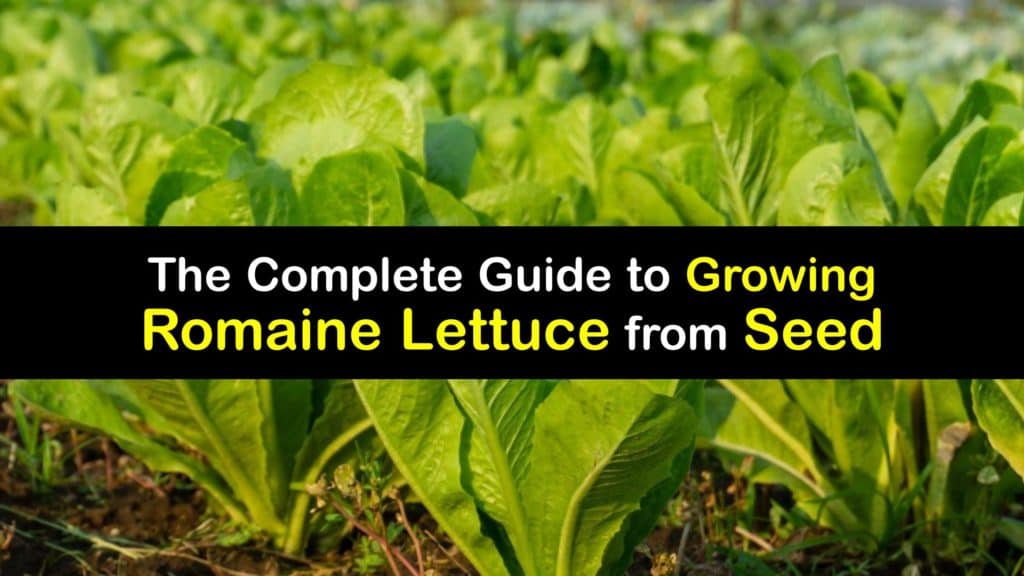Many gardeners and salad enthusiasts question how to grow romaine lettuce from seed. This classic salad green is one of the easiest crops to grow in raised beds and containers or the ground, and it’s ideal for harvesting early in the spring and alongside your fall vegetables.
Harvest baby greens approximately a month after sowing, and complete lettuce heads are harvested in two months or sooner. Growing romaine lettuce from seed is a worthwhile endeavor with a satisfying result.
If you like a tasty salad bowl or crunchy romaine lettuce on your hamburgers, the cost of lettuce at the grocery store quickly adds up. Producing leafy greens is an easy way to save money on groceries while obtaining months of organic romaine lettuce from your own backyard.

All About How to Plant Romaine Lettuce Seeds
If you enjoy salads and have asked how to plant romaine lettuce seeds, know that adding homegrown lettuce to your garden has never been easier. While iceberg lettuce is not the same as romaine, the planting methods are similar.
Lettuce is typically planted in early spring after the last frost for a fall crop. Learning how to grow romaine lettuce from seed is easy and allows you to be self-sufficient while adding a tasty leafy green to your home garden.

Growing romaine lettuce from seed is an appropriate project for all levels of growers and is a perfect choice if you want to see rapid results, as many lettuce varieties are ready to harvest quickly.
This article explains how to plant romaine lettuce seeds, care for your new lettuce plants, and gather your delicious produce and more seeds to have a continuous supply of leafy greens.
How to Grow Romaine Lettuce from Seed
Grow romaine lettuce two ways. One method involves transplanting lettuce seedlings after being cultivated indoors under grow lights or bought from a nursery.
Many growers take care of planting leaf lettuce seeds by starting seeds in a plastic bag to establish an optimum environment for seed germination. Do you know how far apart to plant romaine lettuce? After the seeds germinate, sow them two inches apart in a row in traditional or raised beds enriched with organic matter. Work on spacing each row 12-18 inches apart, though this varies depending on the kind of lettuce.
Because seeds need light to germinate, planting iceberg lettuce and other lettuce varieties requires that you sow them shallowly and cover them with a light coating of potting soil. When you transplant lettuce seedlings, thin the lettuce seedlings to 12 inches apart once they have established a robust root system. Sow the lettuce seeds in bands for a continuous supply of microgreens throughout the growing season.
Space plants intended to produce baby lettuce 6-8 inches apart. This method yields 6-8 inch tall romaine lettuce heads. Grow a single type of lettuce or a variety of leafy greens this way. Growers may use hydroponic methods to grow different lettuce types, as well.
Growing Romaine Lettuce from Seed – Care
Lettuce is an easy-to-grow annual vegetable and is a cool weather veggie that does best in temperatures between 60 and 70℉. Consistent moisture is required for a high-quality harvest of soft, mild-tasting lettuce. Keep your lettuce plant’s soil moist with regular watering. Mulch helps retain moisture.
Lettuce plants are not very heat-tolerant. When stressed by hot weather, full sun, or dehydration, the outer leaves become bitter, and the plants undergo bolting. When bolting, lettuces switch from producing new leaves to flower growth, and a flower stalk appears. Use row covers to protect your lettuce from cold and hot weather and pests like aphids.
How to Harvest Romaine Lettuce Seeds
It’s time to harvest lettuce once a large crop grows in your garden. When it’s romaine lettuce harvest time, choose a handful of young leaves or the entire plant to gather as a baby green. Whether you are harvesting arugula or romaine, selectively pick the outer leaves of varieties with loose heads or loose leaves as the plants grow. Slice the head off one inch above the soil with a sharp, clean knife to harvest the entire head.
To harvest some romaine lettuce seeds to use the following year, allow one or two of your plants to bolt and flower. After you harvest any lettuce and once the flower heads are dry and fluffy, shake them over a plastic bag to collect the seeds.
Other Lettuce Varieties
When growing lettuce from seeds, the first decision is which lettuce variety to grow. Although many gardeners favor loose-leaf lettuce varieties since they develop rapidly and may be picked for weeks, lettuce seeds come in various forms and sizes.
Many kinds of lettuce have distinct features, from coloring and leaf types to growing time and flavor—select lettuces based on your preferred taste and attributes.
Growing lettuce from seed is a great technique to ensure you have nutritious leafy greens on hand. It is a simple crop to raise in your backyard garden and is well-known as a nutritious meal option.
If you’ve ever eaten fresh-picked homegrown lettuce, you know the difference between the deliciously succulent leaves straight from the garden and what you get in the grocery store is enormous. There are a variety of ways to store romaine lettuce and other lettuces so you always have some fresh greens for your meals.
Romaine lettuce, like broccoli, is a household favorite, and fortunately, it’s simple to grow from seed, and the plants don’t take long to mature. Growing lettuce at home is enjoyable and rewarding, making it an excellent addition to any garden.

If you learned from this article on how to grow romaine lettuce from seed, please share this fantastic information on growing romaine lettuce from seed with your friends and family on Pinterest and Facebook.